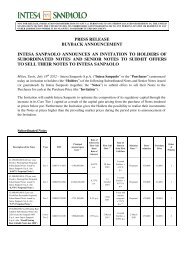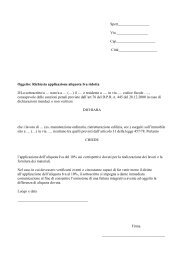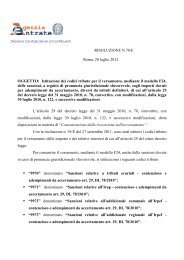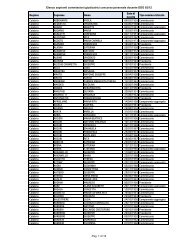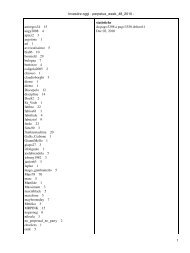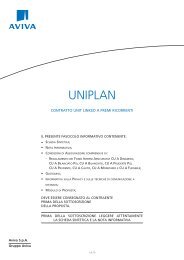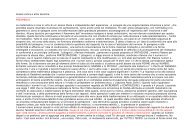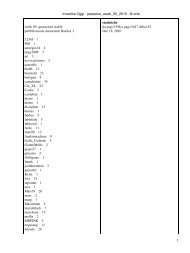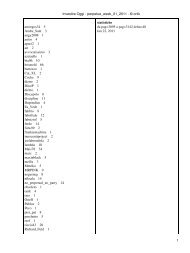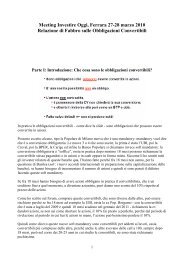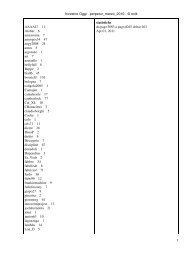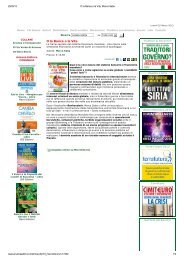SPOTLIGHT ON REUTERS COMMODITY POLLS 2010 - InvestireOggi
SPOTLIGHT ON REUTERS COMMODITY POLLS 2010 - InvestireOggi
SPOTLIGHT ON REUTERS COMMODITY POLLS 2010 - InvestireOggi
Create successful ePaper yourself
Turn your PDF publications into a flip-book with our unique Google optimized e-Paper software.
<strong>SPOTLIGHT</strong> <strong>ON</strong> <strong>REUTERS</strong><br />
<strong>COMMODITY</strong> <strong>POLLS</strong> <strong>2010</strong><br />
TABLE OF C<strong>ON</strong>TENTS:<br />
ENERGY:<br />
Oil price to average $77.50 a barrel in <strong>2010</strong><br />
US natgas <strong>2010</strong> price estimates hold, cold trims<br />
stocks<br />
Coal prices seen firmer in <strong>2010</strong>, may rise strongly<br />
METALS:<br />
Metal prices to rise this year but policy risks loom<br />
China's aluminium splurge to fuel market surplus<br />
China demand to lift iron ore prices by 30 percent<br />
GRAINS:<br />
Big crops to pressure U.S. grain prices in <strong>2010</strong><br />
Bumper soy crop set to limit palm oil gains this yr<br />
SOFTS:<br />
Sugar to scale peaks in <strong>2010</strong>, supply eyed<br />
Supply crunch to bolster cocoa prices in <strong>2010</strong><br />
Robusta seen up 20 pct by year-end; demand firm<br />
-------------------------------------------------------------------------------------<br />
Source: Reuters Pictures<br />
Workers pump gasoline into cars at a petrol station in Sanaa February 1, <strong>2010</strong>.<br />
Yemen, trying to reduce subsidies, increased fuel prices up to 14.3 percent on<br />
Sunday, pumping station owners said. <strong>REUTERS</strong>/Khaled Abdullah (YEMEN -<br />
Tags: ENERGY SOCIETY)<br />
03 FEBRUARY <strong>2010</strong><br />
OIL PRICE TO AVERAGE $77.50 A BARREL IN<br />
<strong>2010</strong><br />
* First stock draw seen in Q3<br />
* U.S. crude oil to average $77.50 in <strong>2010</strong>, $84.60 in 2011<br />
* China loan curbs after record Q4 growth could hit demand<br />
By Chris Baldwin<br />
L<strong>ON</strong>D<strong>ON</strong>, Jan 25 (Reuters) - U.S. crude oil is expected to rise to<br />
an average of $77.50 a barrel in <strong>2010</strong>, a Reuters poll showed on<br />
Monday, but analysts said heavy inventories will keep prices<br />
range-bound until more demand emerges in the third quarter.<br />
The poll of 29 analysts showed a rise in the consensus forecast for<br />
the ninth consecutive month. In April of last year, the average<br />
forecast for <strong>2010</strong> was $65.95 a barrel.<br />
"In the short term, there remains a great deal of uncertainty as to<br />
where the flat price may end up," said senior commodities analyst<br />
Harry Tchilinguirian at BNP Paribas.<br />
"Oil is likely to trade in a wide range over the next 3 to 6 months,<br />
possibly $65 to $85 a barrel. Capped on the upside by weak<br />
fundamentals but supported above a theoretical fundamental level<br />
by still-ample liquidity conditions," he said.<br />
U.S. crude is expected to average $75.20 in the first quarter of<br />
<strong>2010</strong>, up from $73.70 in the last poll, which had also forecast an<br />
average of $74.90 for the fourth quarter of 2009.<br />
U.S. crude prices rose as high as $83.95 in January, spurred by a<br />
prolonged period of below-average temperatures in the northern<br />
hemisphere and robust economic growth in China, the world's<br />
second-largest energy consumer.<br />
On Monday prices dropped back to below $75 a barrel as<br />
investors turned to safer assets following U.S. President Barack<br />
Obama's moves to curb risk-taking among banks last week.<br />
"In the short term a stronger dollar and the still very high level of<br />
crude stocks could mean that the current correction will lead us to<br />
$70 again," said analyst Frank Schallenberger at Landesbank.<br />
"In the long term the still very strong appetite for oil (Chinese<br />
markets went up 14 percent last year) from emerging markets will<br />
take prices higher again."<br />
The latest poll's forecast for U.S. crude to average $77.50 a barrel<br />
for <strong>2010</strong> as a whole compared with a forecast of $76.40 in the<br />
December survey.<br />
SUPPLY OVERHANG<br />
Analysts said likely credit tightening in China might pressure global<br />
oil prices, as building and construction might shrink along with the<br />
fuel needed for the transport and trucking industry, with support<br />
not seen until the third quarter.<br />
"China appears likely to move toward more restrictive monetary<br />
policy, cutting support to energy intensive investment in housing or<br />
primary industries," said Christophe Barret at Calyon.
<strong>SPOTLIGHT</strong> <strong>ON</strong> <strong>REUTERS</strong> <strong>COMMODITY</strong> <strong>POLLS</strong> <strong>2010</strong> 03 FEBRUARY <strong>2010</strong><br />
Chinese banking authorities ordered some big banks to curb lending<br />
last week for the remainder of the month, intensifying their efforts to<br />
prevent the world's second-largest economy from overheating.<br />
"Our oil balances result in slight stock builds in Q1, <strong>2010</strong> and Q2,<br />
<strong>2010</strong>, putting downward pressure on prices. The first stock draw<br />
occurs in Q3, <strong>2010</strong>, supporting prices over $70 a barrel in H2 <strong>2010</strong>,"<br />
Barret said.<br />
Oil prices in 2009 ran parallel with global stock market rallies and<br />
some currency valuations, as risk appetite worked back into markets<br />
following a credit crunch, the financial crisis and an eventual<br />
widespread recession.<br />
The U.S. dollar touched record lows against a basket of other major<br />
currencies for more than a year, bottoming out in November only to<br />
regain more than 5 percent in December.<br />
A weaker dollar supports oil because dollar-priced commodities<br />
become cheaper for buyers using other currencies.<br />
CFTC IMPLEMENTATI<strong>ON</strong><br />
Analysts said it was a matter of time before legislation curtailed<br />
excessive speculation in the futures market for U.S. crude, often<br />
referred to as West Texas Intermediate (WTI).<br />
The U.S. Senate Energy and Natural Resources Committee<br />
postponed a hearing last week to review the Commodity Futures<br />
Trading Commission's proposal to impose position limits on certain<br />
energy contracts.<br />
"For the second half of the year we will flag the implementation of the<br />
CFTC rules on limits in Energy Futures which we believe could have<br />
a negative impact on WTI but positive on Brent Futures ," said Olivier<br />
Jakob at Petromatrix.<br />
Analyst Jane Foley at Gain Capital-FOREX said last year's price rally,<br />
in spite of high inventories, suggested speculative demand was rife<br />
among market trades.<br />
"Regulation and the likely commencement this year of central banks<br />
mopping up excess liquidity suggests this will bring prices lower."<br />
(Editing by Anthony Barker)<br />
-------------------------------------------------------------------------------------<br />
US NATGAS <strong>2010</strong> PRICE ESTIMATES HOLD,<br />
COLD TRIMS STOCKS<br />
* Analysts leave <strong>2010</strong> price estimates unchanged<br />
* Cold winter trims inventories from record-high levels<br />
* Concerns persist about rising rig counts and LNG imports<br />
By Joe Silha<br />
NEW YORK, Jan 29 (Reuters) - Energy analysts kept their forecasts<br />
for U.S. natural gas prices this year nearly steady from last quarter<br />
after a six-week cold snap this winter lifted demand and sharply cut<br />
inventories from the record highs seen at the start of the heating<br />
season.<br />
After steadily trimming their forward price outlooks last year when a<br />
deep recession and strong domestic production kept the market<br />
oversupplied, most analysts see a slightly tighter balance in <strong>2010</strong> as<br />
the economy improves.<br />
The Reuters quarterly poll put the consensus forecast for spot prices<br />
this year at Henry Hub, the benchmark U.S. supply point in Louisiana,<br />
at an average $5.87 per million British thermal units, little changed<br />
from last quarter's estimate but up nearly 50 percent from 2009's<br />
average of $3.99.<br />
Of the 26 industry participants, nine revised upward their forecasts<br />
from early October, while nine cut them. The rest were unchanged or<br />
did not participate in the previous poll.<br />
Prices are expected to climb 9 percent in 2011 to $6.40 as<br />
demand, particularly from industrial users, picks up with the<br />
economy, but estimates for next year were scaled down by more<br />
than 6 percent from the previous quarterly poll.<br />
But many also note that there are several factors that could limit<br />
price gains this year and in 2011.<br />
"The storage draws were bullish for gas prices, but the global<br />
flexibility in LNG (liquefied gas) and the anxiousness to push the<br />
gas rig count up really mitigate a good bit of that bullishness," said<br />
Jen Snyder at consultants Wood Mackenzie.<br />
As the economic recovery picks up speed, prices in 2012 were<br />
seen averaging $6.76, up another 5 percent.<br />
STORAGE, <strong>ON</strong>E LESS PROBLEM FOR BULLS<br />
One big change for the natural gas price outlook this year has<br />
been storage, which started the heating season at a record high<br />
3.837 trillion cubic feet as recession-related cuts in industrial<br />
demand, strong domestic production and a cool summer kept the<br />
market oversupplied throughout 2009.<br />
In November, many analysts had expected inventories to end the<br />
heating season at record highs in the 1.9 tcf area, but the steady<br />
cold since early December and subsequent strong storage draws<br />
have prompted lower end-winter estimates of 1.6 tcf.<br />
Some 665 bcf of gas was pulled from storage in December, versus<br />
a more normal decline of 500 bcf, and analysts expect another 725<br />
bcf or more to be tapped in January, also well above the average<br />
draw for that month of about 625 bcf.<br />
Recent U.S. Energy Information Administration data showed total<br />
domestic gas inventories had slipped to 2.521 tcf, still 5 percent<br />
above last year and 4 percent above the five-year average but well<br />
below the surplus in early December that stood at nearly 16<br />
percent above normal for that time of year.<br />
Utilities typically build up inventories from April through October to<br />
help meet 25 percent of peak winter heating needs.<br />
Excess storage supplies give utilities more discretion when buying<br />
and last year helped pressure late summer Henry Hub cash prices<br />
to 7-1/2-year lows below $2 before a chilly October and then a<br />
cold December more than doubled prices to above $5.<br />
Of course a mild February and March could set the storage<br />
surplus growing again, but several private forecasters are still<br />
looking for a cold finish to the heating season.
<strong>SPOTLIGHT</strong> <strong>ON</strong> <strong>REUTERS</strong> <strong>COMMODITY</strong> <strong>POLLS</strong> <strong>2010</strong> 03 FEBRUARY <strong>2010</strong><br />
STILL PROBLEMS FOR THE BULLS<br />
But despite the improved storage picture, most analysts agree there<br />
are still potential problems for the bulls.<br />
The steep decline in U.S. gas drilling last year prompted expectations<br />
production would slow significantly this year, but as gas prices<br />
doubled in the fourth quarter, the rig count started rising again and<br />
output never dropped much, primarily due to increased production<br />
from shale gas.<br />
The number of U.S. rigs drilling for natural gas now stands at a 10month<br />
high of 833, up 25 percent since bottoming at 665 in July,<br />
according to recent data from Baker Hughes.<br />
While EIA still expects domestic gas production to fall 3 percent this<br />
year, as strong initial output from newly drilled wells tapers off, not all<br />
analysts agree.<br />
"Gas-directed drilling is recovering faster than we had expected,<br />
posing downside risks to prices later in <strong>2010</strong>," Barclays Capital said<br />
in a research report this week, who estimate that Henry Hub prices<br />
will average $5.25 this year.<br />
Analysts note there are huge reserves of shale gas, some located<br />
near existing drilling and pipeline operations, that can be readily<br />
tapped should prices climb too far.<br />
While environmental concerns, particularly about water quality, could<br />
slow shale development, they are unlikely to stop output, which is<br />
profitable at many basins when prices trade between $5 and $6 and<br />
could cap future price gains.<br />
Another problem for would-be bulls is the strength of the economic<br />
recovery, which so far looks sluggish.<br />
"We're looking for a recovery in natural gas demand from the<br />
industrial sector in <strong>2010</strong>, but it's not projected to be large enough to<br />
absorb the supply overhang if producers don't scale back," said S&P<br />
oil and gas equity analyst Tina Vital, who forecasts a $3.94 average<br />
at Henry Hub in <strong>2010</strong>.<br />
A deep recession last year sharply cut gas demand, particularly from<br />
the industrial sector which dropped more than 8 percent in 2009 and<br />
accounts for nearly 30 percent of total consumption.<br />
Strong fourth quarter GDP data on Friday could raise hopes for a<br />
faster-than-expected recovery this year.<br />
EIA expects U.S. gas demand in <strong>2010</strong> to hold steady, as gains in the<br />
residential, commercial and industrial sectors offset declining electric<br />
power use, and that should tighten the overall balance if output falls<br />
as expected.<br />
LNG, ANOTHER WILD CARD<br />
But liquefied natural gas imports remain a big wild card this year, with<br />
many expecting new global liquefaction projects to drive more supply<br />
to U.S. shores and pressure prices.<br />
While pipeline imports from Canada, which typically meet about 15<br />
percent of total U.S. needs, are expected to fall this year, analysts<br />
note it will not be enough to offset projected gains in LNG, which<br />
could double this year to more than 2.5 bcf per day from the 2009<br />
average of about 1.3 bcf daily.<br />
(Reporting by Joe Silha; Editing by John Picinich)<br />
-------------------------------------------------------------------------------------<br />
COAL PRICES SEEN FIRMER IN <strong>2010</strong>, MAY<br />
RISE STR<strong>ON</strong>GLY<br />
* China coal imports to rise in <strong>2010</strong>, boost global prices<br />
* India imports seen rising, S.Africa to supply more<br />
* Europe demand seen shrinking slightly, more oversupply<br />
By Jackie Cowhig<br />
L<strong>ON</strong>D<strong>ON</strong>, Feb 2 (Reuters) - Physical coal prices on average are<br />
seen strengthening by around $1-$5 a tonne in <strong>2010</strong> on strong<br />
Asian demand and supply bottlenecks could lead to a much<br />
steeper price rise, a Reuters poll of analysts showed.<br />
Twenty analysts and industry players polled by Reuters in January<br />
forecast modest price gains for the three main benchmarks --<br />
thermal coal delivered into Europe and free on board (FOB) South<br />
African and Australian ports.<br />
The median forecast for coal delivered Amsterdam-Rotterdam-<br />
Antwerp (DES ARA) in <strong>2010</strong> was $90.00 a tonne. For South<br />
Africa's Richards Bay the forecast was $85.00 a tonne FOB while<br />
for Australia's Newcastle the median view was $89.00 a tonne<br />
FOB.<br />
On Tuesday the spot price DES ARA was $78 a tonne, Richards<br />
Bay coal was at $80-$86 and Newcastle was at $90.<br />
The strength of a <strong>2010</strong> price rise depends almost entirely on how<br />
much China buys, and this is unpredictable, they said.<br />
"Despite coal being one of worst performing commodities in 2009,<br />
prices are set to increase strongly," said Amrita Sen, analyst with<br />
Barclays Capital in London.<br />
"China remains the key to our global balances, and with the<br />
expectation of a slow but steady recovery in Europe, the supply<br />
bottlenecks that plagued the coal market in early 2008 could well<br />
re-emerge this year," she said.<br />
Prices rose by around 30 percent between November and late<br />
January largely due to China's voracious appetite for coal.<br />
Supply<br />
bottlenecks<br />
on key<br />
railway lines<br />
in Russia and<br />
South Africa<br />
and at ports<br />
in Australia<br />
will mean<br />
more hot<br />
spots will<br />
develop,<br />
particularly in Asia, where strong demand and limited supply due<br />
to logistical limits will draw coal from far afield.<br />
"Looking at the global markets we expect demand to keep<br />
exporters straining to maximise supply," said Brendan Fitzpatrick,<br />
Sydney-based research analyst at Deutsche Bank.<br />
Logistical constraints could boost coal prices by 15-20 percent,<br />
according to Barclays Capital's Sen.<br />
BROAD-BASED DEMAND RECOVERY<br />
Predicted strong growth in Asia and a slower recovery in Europe<br />
and the U.S. look supportive for coal, analysts said.<br />
"Against expectations for an improving macro backdrop, we expect<br />
a broader-based recovery in demand from other parts of Asia and,<br />
to a lesser extent, the West," Sen said.
<strong>SPOTLIGHT</strong> <strong>ON</strong> <strong>REUTERS</strong> <strong>COMMODITY</strong> <strong>POLLS</strong> <strong>2010</strong> 03 FEBRUARY <strong>2010</strong><br />
"Overall, price risks are skewed to the upside, particularly in<br />
Newcastle and API4 (Richards Bay)," she added.<br />
Global thermal coal seaborne trade is around 640 million tonnes a<br />
year, split between 400 million within the Pacific region and 240 in<br />
the Atlantic.<br />
Coal demand in Asia will continue to outstrip slowly shrinking<br />
European demand as South East Asia and East Asia ramp up coalfired<br />
power generation. Strong Pacific prices will continue to support<br />
European prices to a certain extent.<br />
CHINA IMPORTING<br />
China became a net importer in 2009 and is likely to continue to draw<br />
coal from the Atlantic basin, analysts said.<br />
"China is likely to remain a net importer for 3-5 years as further small<br />
mines are closed and consolidated," said Deutsche Bank's<br />
Fitzpatrick.<br />
China, the world's biggest coal producer, will import whenever it is<br />
cheaper to do so or domestic supply is disrupted.<br />
The country imported over 50 million tonnes of thermal coal in 2009<br />
and this alone prevented a global coal price slump.<br />
"China thermal import demand we see at 55 million tonnes in <strong>2010</strong>,<br />
rising to 60 million tonnes in 2011," said Emmanuel Fages, analyst at<br />
Societe Generale in Paris."<br />
China's emergence as a huge importer has heightened the existing<br />
imbalance between the Atlantic and Pacific.<br />
"Pacific supply we see at 360 million tonnes for <strong>2010</strong> against<br />
demand of 405 million. In 2011 we see supply of 372 million tonnes<br />
against demand of 424 million," Fages said.<br />
Atlantic coal supply is forecast at 273 million tonnes against demand<br />
of 235 million, rising to supply of 285 million and demand of 237<br />
million in 2011, he added.<br />
INDIAN GROWTH<br />
India is seen continuing to dictate prices for South African coal in<br />
<strong>2010</strong> and beyond as exporters switch increasing tonnages away from<br />
Europe to Asia, analysts said.<br />
Continued strong Indian demand will keep Richards Bay prices close<br />
to parity or even at a premium to delivered Europe levels.<br />
"(For) India we see thermal coal import demand at 45 million tonnes<br />
for <strong>2010</strong>, rising to 48 million in 2011," said Fages.<br />
India took around 18 million tonnes of South Africa's 60 million<br />
exports in 2009 and this is likely to rise to over 20 million in 2011.<br />
(Additional reporting by Fayen Wong, editing by Anthony Barker)<br />
-------------------------------------------------------------------------------------<br />
METAL PRICES TO RISE THIS YEAR BUT POLICY<br />
RISKS LOOM<br />
* Copper, aluminium, tin trading above <strong>2010</strong> forecasts<br />
* Tighter monetary/fiscal policy to weigh on price in H2<br />
* Chinese growth to remain strong but import demand may wane<br />
By Maytaal Angel<br />
L<strong>ON</strong>D<strong>ON</strong>, Jan 26 (Reuters) - Economic recovery and strong demand<br />
from China will propel base metals higher this year, although tighter<br />
monetary and fiscal policies will weigh on prices in the second half, a<br />
Reuters survey showed.<br />
The survey of 57 base metals analysts taken this month showed<br />
average cash copper prices will rise by 37 percent year-on-year,<br />
aluminium by 25 percent and nickel by 24 percent.<br />
Sister metals lead<br />
and zinc will rise<br />
by 31 percent and<br />
38 percent<br />
respectively, while<br />
tin, the laggard of<br />
the complex, will<br />
clock up gains of<br />
20 percent.<br />
"The start of the<br />
new year has<br />
seen money continue to flow into commodities while risks appetite<br />
has also increased amid plentiful liquidity and optimism over the<br />
ongoing recovery," said Leon Westgate at Standard Bank.<br />
"There are still risks however, with arguably the largest being<br />
concerns about China curbing spending, the over-reliance on<br />
stimulus measures for growth, and fluctuations in the currency<br />
markets," Westgate added.<br />
Others were more cautious, saying tighter monetary policy, the<br />
withdrawal of stimulus measures, market regulation, the end of<br />
Western world restocking and possible Chinese destocking would<br />
actually lower prices towards the end of the year.<br />
As a consequence, the price forecasts -- while comfortably above<br />
last year's averages -- are actually near or below current price<br />
levels. Copper, for example, is forecast to average $7,077 a tonne<br />
versus $5,178, but was trading around $7,345 at mid-morning on<br />
Tuesday on the London Metal Exchange.<br />
Next year it is forecast to average $7,500 a tonne, while<br />
aluminium , used in transport and packaging, is seen averaging<br />
$2,094 a tonne this year and $2,226 next year, versus $1,671 last<br />
year. It was trading around $2,200 a tonne mid-morning on<br />
Tuesday.<br />
"The second half of <strong>2010</strong> could be pivotal. Monetary policy<br />
normalisation, rising interest rates and taxes, the unemployment<br />
and debt burden and producer capacity reactivation - all scream<br />
prudence," RBS said.<br />
THE PACE OF GAINS<br />
Prices of copper, used in power and construction, surged around<br />
140 percent last year, boosted by a restocking drive in top<br />
consumer China, recovery of major economies from recession,<br />
strong fund flows and a declining U.S. dollar.<br />
Other metals followed suit, with top performer lead rising 144<br />
percent and laggard tin gaining 58 percent, but analysts warn that<br />
if any of the above factors diminish or reverse this year, the pace<br />
of gains in metals will decline.<br />
Of particular concern is monetary and fiscal policy and how it will<br />
impact fund flows and shape the outlook for economic growth,<br />
inflation and the dollar -- weakness in which drives dollar-priced<br />
metals higher.<br />
Metals have declined for most of the past week on concerns over<br />
looming monetary tightening in China and proposals for sweeping<br />
restrictions on U.S. banks that could squeeze liquidity and crimp<br />
demand from investors.<br />
Lower liquidity poses a particular risk for aluminium, a metal<br />
plagued by structural oversupply, but where cheap money has<br />
resulted in financing deals that have tied up around 70 percent of<br />
the record 4.6 million tonnes of London Metal Exchange stocks.<br />
"Super low U.S. interest rates have encouraged many investors to<br />
take physical delivery of certain commodities and sell forward to<br />
extract carry. This has been a feature of the aluminium market. A<br />
more aggressive turn in U.S. interest rates at the end of this year<br />
would threaten to undermine such strategies," said Michael Lewis<br />
at Deutsche Bank.
<strong>SPOTLIGHT</strong> <strong>ON</strong> <strong>REUTERS</strong> <strong>COMMODITY</strong> <strong>POLLS</strong> <strong>2010</strong> 03 FEBRUARY <strong>2010</strong><br />
A YEAR OF TWO HALVES<br />
For less over-supplied metals like lead, and to a lesser extent zinc,<br />
prospects are better but even these metals face the risk of mine and<br />
smelter restarts, and a more moderate pace of import demand from<br />
China.<br />
Galvanising metal zinc is expected to average $2,293 a tonne this<br />
year compared with $1,662 last year; while battery material lead is<br />
seen averaging $2,252 this year versus $1,726 last year.<br />
The two, along with their counterparts nickel and tin -- forecast to<br />
average $18,185 versus $14,712 and $16,294 versus $13,618,<br />
respectively -- will also be hard pressed to escape the effects of<br />
monetary tightening.<br />
"We see a year of two halves. The liquidity story that underpinned<br />
metals in the second half of 2009 after the Chinese restocking faded<br />
is expected to persist into the first half of <strong>2010</strong>. Fresh highs are seen<br />
in all metals save for nickel," said Michael Jansen at JP Morgan.<br />
But he added that "a solid retracement is seen in the second half of<br />
<strong>2010</strong>" as global liquidity lessens, supplies grow and tighter monetary<br />
and fiscal policies boost the dollar and dent the appeal of<br />
commodities as a hedge against inflation.<br />
(Graphics by Scott Barber)<br />
Additional reporting by Jan Harvey, Pratima Desai, Carole Vaporean,<br />
Chris Kelly, Rujun Shen, Nick Trevethan, Polly Yam, Himangshu<br />
Watts, Ruchira Singh, Humeyra Pamuk, Karen Norton, and Rebekah<br />
Curtis, editing by Sue Thomas)<br />
-------------------------------------------------------------------------------------<br />
CHINA'S ALUMINIUM SPLURGE TO FUEL<br />
MARKET SURPLUS<br />
* China flooding aluminium mkt, surplus to balloon in <strong>2010</strong><br />
* Copper surplus forecasts halved<br />
* Surpluses to grow in lead, zinc, tin and nickel<br />
By Pratima Desai<br />
L<strong>ON</strong>D<strong>ON</strong>, Jan 26 (Reuters) - A massive rise in aluminium supplies<br />
from China and anaemic demand growth mean a larger market<br />
surplus than many were previously expecting, a Reuters survey<br />
showed.<br />
The survey of 22 analysts taken in January showed the average<br />
forecast for the aluminium surplus this year was 1.05 million tonnes<br />
compared with 695,100 tonnes in the July survey.<br />
"There has been a<br />
massive increase in<br />
supply of aluminium,<br />
especially from China,<br />
which is producing at<br />
almost full capacity," said<br />
Daniel Briesemann,<br />
analyst at Commerzbank.<br />
"China is flooding the<br />
market with aluminium."<br />
China's government, determined to make sure economic growth held<br />
up, last year offered financial assistance to many firms, including<br />
aluminium producers, to keep going, analysts say.<br />
The country produced 13.105 million tonnes of aluminium in 2008,<br />
according to the International Aluminium Institute.<br />
Between January and November 2009 it produced 11.633 million<br />
tonnes. Expectations are for the final year figure to match 2008. A<br />
number around 15 million tonnes is expected for <strong>2010</strong>.<br />
Aluminium demand this year is estimated at about 37 million<br />
tonnes from about 35-36 million tonnes in 2009. Analysts expect<br />
demand for aluminium from the transport and packaging industries<br />
to grow in <strong>2010</strong>, but not at the pace of rising supplies.<br />
That is why they expect a larger surplus, much of which will find its<br />
way to official stocks.<br />
Stocks of aluminium in London Metal Exchange warehouses are<br />
hovering near record highs of 4.64 million tonnes set last week.<br />
"The surplus will take time to eradicate, to get back to a normal<br />
market," said Robin Bhar, analyst at Calyon.<br />
E-BIKES AND AUTOMOBILES<br />
The average forecast for the copper surplus this year is 115,000<br />
tonnes from 227,300 tonnes in the July survey.<br />
Strong economic growth and demand from China are behind the<br />
cuts to forecasts, some are even expecting a deficit this year.<br />
"Copper: We look for a "market deficit" partly due to tighter supply,<br />
as a result of (for example) falling ore grades, and partly due to<br />
rising demand (for example), the construction sector fights back,"<br />
Danske Bank told Reuters.<br />
Some analysts expect China, the world's largest consumer of<br />
industrial metals, to start stockpiling copper again this year and<br />
that too will take material out of the market. Much of the fall in<br />
stocks last year was attributed to China stockpiling.<br />
"Further stock building by strategic government agencies could<br />
take up further excess inventory," said John Meyer, analyst at<br />
investment bank Fairfax.<br />
"Asian governments appear concerned that a return to coordinated<br />
economic growth could lead to a rapid return to the shortages that<br />
threatened ... prior to the Beijing Olympics."<br />
In contrast, battery material lead is expected to show a bigger<br />
surplus this year -- 62,500 tonnes from 34,500 tonnes in the July<br />
survey.<br />
"With developed economy auto sales unlikely to have a strong<br />
year, we expect a surplus despite strong growth in demand out of<br />
China from e-bikes and automobiles," said Justin Lennon, analyst<br />
at Mitsui Bussan Commodities.<br />
For stainless steel ingredient nickel the forecast shows a surplus<br />
of 15,000 tonnes in <strong>2010</strong> compared with an average of 9,000<br />
tonnes in the July survey.<br />
In tin, the consensus is for a surplus of 2,000 tonnes from a deficit<br />
of 1,500 tonnes and for zinc the numbers are 209,500 and 12,000<br />
tonnes respectively.<br />
"The zinc industry has a history of lacking discipline and this is<br />
becoming evident as smelters, even in the Western world, rushed<br />
to restart previously idled capacity in the second half of last year,"<br />
Standard Bank said in a note.<br />
Reporting by Maytaal Angel, Jan Harvey, Pratima Desai, Carole<br />
Vaporean, Chris Kelly, Rujun Shen, Nick Trevethan, Polly Yam,<br />
Himangshu Watts, Ruchira Singh, Humeyra Pamuk, Karen Norton,<br />
Rebekah Curtis; graphics by Scott Barber; editing by Sue Thomas)<br />
-------------------------------------------------------------------------------------
<strong>SPOTLIGHT</strong> <strong>ON</strong> <strong>REUTERS</strong> <strong>COMMODITY</strong> <strong>POLLS</strong> <strong>2010</strong> 03 FEBRUARY <strong>2010</strong><br />
CHINA DEMAND TO LIFT IR<strong>ON</strong> ORE PRICES BY<br />
30 PERCENT<br />
* Forecasts for iron ore price rise vary from 15 to 40 pct<br />
* Booming Chinese demand, tight supplies to drive prices<br />
* Analysts see Japanese settling first, China could use spot<br />
By Humeyra Pamuk<br />
L<strong>ON</strong>D<strong>ON</strong>, Jan 27 (Reuters) - Benchmark iron ore prices are set to<br />
rise by 30 percent for the <strong>2010</strong>/2011 contract term, due to soaring<br />
demand from top importer China, where steel output is running at<br />
record highs, a Reuters survey showed on Wednesday.<br />
The price increase will almost reverse last year's 33 percent cut,<br />
settled during the global economic downturn, and will mark the<br />
second-highest ever price for iron ore.<br />
Five participants in<br />
the poll of 13<br />
analysts, conducted<br />
in the last two weeks,<br />
estimated Australian<br />
ore prices to rise<br />
above the median<br />
forecast of 30<br />
percent and up to 40<br />
percent in the annual<br />
contract talks, which<br />
are expected to start<br />
soon.<br />
Several analysts predicted they would need to revise prices upwards<br />
again soon as the outlook was increasingly bullish.<br />
"China is the major driver," said Daniel Brebner, analyst at Deutsche<br />
Bank. "The fact that we have had such a significant recovery in<br />
demand from the most important consumer in the market justifies the<br />
price hike in iron ore," he said.<br />
The world's top steel producer's insatiable appetite boosted iron ore<br />
prices in the spot market to around $135-137 a tonne in mid-January<br />
for Indian ores containing 63.5 percent iron ore.<br />
Despite a slight fall to below $130 a tonne since then, prices are still<br />
up around 64 percent since last September.<br />
Spot prices also reflect a massive premium over the Japanese<br />
benchmark settled for 2009/<strong>2010</strong>, which was $60 per tonne for fines<br />
with 62 percent iron ore, excluding freight.<br />
Analysts say producers are stretched to meet the demand from<br />
China, even though demand from Europe, Japan and South Korea<br />
remains relatively subdued.<br />
"We do not see a global iron ore supply response in the short term<br />
sufficient to offset the increasing demand," RBC Capital Markets said<br />
in a research note.<br />
Iron ore output from BHP Billiton, the world's top miner, rose by 11<br />
percent in the last quarter of 2009 to meet demand from importreliant<br />
China. The country's December iron ore imports from<br />
Australia surged by 40 percent.<br />
Mining giants Vale of Brazil and Australia's Rio Tinto and BHP Billiton<br />
control the $80 billion iron ore business.<br />
China's steel production rose by 13.5 percent in 2009 to a record<br />
high of nearly 570 million tonnes, while output in the ex-China world<br />
dropped more than 20 percent, figures from the World Steel<br />
Association showed last week.<br />
JAPANESE FIRST?<br />
Contract talks on the iron ore price are expected to be intense and<br />
lengthy, as always. There will also be a tough debate about the<br />
future of the pricing mechanism.<br />
After last year's tense stand off betweeen Chinese steelmakers<br />
and the world's top mining companies, analysts expect market<br />
maker miners will aim to settle with Japanese buyers -- which<br />
could make China follow suit or buy from the spot market again.<br />
In 2009 Chinese steelmakers, seeking a deeper price cut than that<br />
one by Japanese peers, never officially struck a term deal and had<br />
to pay higher spot prices.<br />
"The likelihood is we see a resolution between the traditional<br />
buyers -- Japan and Europe -- and one of the producers, before<br />
we see any kind of resolution with the Chinese," Brebner at<br />
Deutsche said.<br />
Delays in settling 2009 term contracts cost chief negotiator China<br />
Iron and Steel Association dearly in terms of bargaining power, as<br />
demand revived and China's growth remained strong.<br />
The failure to resolve annual price talks in 2009 may also mean<br />
spot prices play a pivotal role in <strong>2010</strong> as the starting point for talks<br />
rather than the previous year's settlement.<br />
"I see China moving increasingly towards the spot market," said<br />
David Tucker, managing consultant at Hatch Beddows. "In the first<br />
half of 2009, everything that was going into China was spot," he<br />
said.<br />
Other winners from the breakdown of the benchmark pricing<br />
system are banks, brokers and exchanges that have been racing<br />
to launch alternative instruments.<br />
So far, the most popular appear to be iron ore swap contracts,<br />
particularly with the introduction of clearing.<br />
"They're filling a need but it's still in early days and I'm not sure<br />
there's enough liqudity in these products for a buyer to go out and<br />
hedge its needs. But definitely, it's got legs to grow," Tucker said.<br />
(Reporting by Humeyra Pamuk, Editing by Anthony Barker)<br />
-------------------------------------------------------------------------------------<br />
BIG CROPS TO PRESSURE U.S. GRAIN PRICES<br />
IN <strong>2010</strong><br />
* Big crops to weigh on corn, soy, wheat prices<br />
* Huge South American soybean crop pressuring prices<br />
* Bulls see recovering global economy lifting grains<br />
By Sam Nelson<br />
CHICAGO, Jan 27 (Reuters) - Big global production of grains and<br />
a rebound in South American soybean output will keep pressure<br />
on Chicago Board of Trade corn, soybean and wheat futures<br />
prices through the end of <strong>2010</strong>, a Reuters poll showed.<br />
The poll of 14 analysts showed the year-end spot price for<br />
soybeans at $9.09 per bushel, down 12.6 percent from last year;<br />
corn at $3.84, down 7.5 percent; wheat at $5.27, down 2.8 percent<br />
and soyoil at 37.87 cents per lb, down 6 percent.<br />
The poll also showed<br />
that wheat and<br />
soybean prices on<br />
June 30, <strong>2010</strong>,<br />
would be lower than<br />
at mid-year 2009,<br />
but the average corn<br />
price may be up a<br />
little as first-half<br />
<strong>2010</strong> corn supplies<br />
tighten.<br />
"There will be a lot of soybeans in the world this year. The crop will<br />
be big in South America and we need to reflect that," said Jack<br />
Scoville, an analyst for brokerage The Price Futures Group.
<strong>SPOTLIGHT</strong> <strong>ON</strong> <strong>REUTERS</strong> <strong>COMMODITY</strong> <strong>POLLS</strong> <strong>2010</strong> 03 FEBRUARY <strong>2010</strong><br />
Soybean prices held very strong through most of 2009 because of an<br />
unprecedented drought in South America, the world's largest<br />
soybean producing region.<br />
Persistent buying of soybeans from the United States by China, the<br />
largest global soy importer, also lifted prices.<br />
RECORD SOY CROP FROM S. AMERICA<br />
Now, South America is expected to produce a record soybean crop<br />
and there are concerns about the fate of China's soy buying pattern<br />
as the government begins to clamp down on bank lending to cool off<br />
the perceived overheated Chinese economy.<br />
"It is all about supplies. We think the (soybean) supplies overcome<br />
the demand, unless we change the policy and we go to less acres,"<br />
said Don Roose, analyst and president of U.S. Commodities in Des<br />
Moines, Iowa.<br />
Roose also thinks China will slow down its purchases.<br />
Record large American corn and soy production last year and<br />
forecasts for the largest stockpile of U.S. wheat in 20 years will<br />
combine to keep pressure on each market and while there will be<br />
peaks and valleys for prices this year, the analysts don't expect to<br />
see the huge price swings of 2008 and 2009.<br />
"Corn prices are set to decline during the first six months on record<br />
supplies and only modest increases in feed demand and exports,"<br />
said Terry Reilly, an analyst for Citigroup. "Wheat will remain on the<br />
defensive on comfortable global and U.S. stocks. U.S. exports are<br />
not expected to recover until the <strong>2010</strong>/11 crop year," he said.<br />
There were a wide range of estimates and market bulls maintain that<br />
as the global economy recovers, grain and soybean markets also<br />
may move higher.<br />
They also think that the big crop production has been factored into<br />
the markets that are roughly half the price they were during the race<br />
to record high prices in mid-2008.<br />
"Considering where we were in 2008, these are pretty cheap prices,"<br />
said Tim Hannagan, analyst for PFGBEST.<br />
American farmers slashed their wheat plantings for the <strong>2010</strong> harvest<br />
and are instead sowing corn and soybeans.<br />
"Essentially, you planted a lot less wheat this year. Sure you have<br />
large ending stocks ... but the top of the mountain is now in and<br />
stocks will begin to decline," Hannagan said.<br />
Corn and soyoil prices will be underpinned by their growing use in<br />
the biofuels industry but prices still will struggle because of the<br />
building supplies.<br />
(Reporting by Sam Nelson, Julie Ingwersen, Mark Weinraub, Karl<br />
Plume, Mike Hirtzer; Editing by K.T. Arasu and Lisa Shumaker)<br />
-------------------------------------------------------------------------------------<br />
BUMPER SOY CROP SET TO LIMIT PALM OIL<br />
GAINS THIS YR<br />
* Markets favouring buyers due to ample vegoil supplies<br />
* Soy crop starting to weigh on palm oil prices since Oct.<br />
By Niluksi Koswanage<br />
KUALA LUMPUR, Jan 26 (Reuters) - Average palm oil prices in Asia<br />
are set to rise at a slower pace this year and the next as gains from<br />
strong global demand are curbed by record vegetable oil output, a<br />
Reuters survey showed on Tuesday.<br />
The poll of 19 analysts covering top palm oil producers Indonesia<br />
and Malaysia indicated that price views for palm oil this year have<br />
risen 7.7 percent to a median 2,450 ringgit ($719.5) per tonne from<br />
2,275 ringgit per tonne in a similar survey in July.<br />
Most of the gains are expected in the first quarter of <strong>2010</strong> due to<br />
seasonally weaker palm oil output and strong demand from China<br />
in the run-up to the Lunar New Year in mid-February.<br />
But prices may get reined in after rival soyoil hits the market<br />
around March as record soybean crops in the United States and<br />
South America get harvested.<br />
Based on a growing supply scenario -- the analysts who were<br />
surveyed over two weeks -- put 2011 prices at 2,550 ringgit, up 2<br />
percent from this year's forecast.<br />
"It is a bearish scenario. We think prices should not be all that<br />
much higher than last year," said Alvin Tai, an analyst with OSK<br />
Investment Bank. "Demand is constantly growing but the market<br />
needs to create a spike in orders for any strong price gain."<br />
Reflecting divided opinions on how much of a market share soyoil<br />
could grab from palm oil, which has much higher yields, estimates<br />
ranged widely between 2,200 and 2,750 ringgit for this year and<br />
between 2,100 and 2,900 for the next.<br />
Traders say palm oil's discount to soyoil tumbled 60-70 percent to<br />
$30-40 a tonne last Friday, from about $100 in December, after a<br />
bumper U.S. soy crop started dominating the market from October<br />
onwards.<br />
Brazil and Argentina -- the world's second- and third-largest<br />
producers of soybeans, respectively -- will take control from April<br />
onwards and are expected to flood the global vegetable oil market,<br />
judging by the rising plantings, larger acreage and more<br />
favourable weather.<br />
BUYERS' MARKET<br />
Palm oil's fortunes this year hinge on the buying patterns from top<br />
consumers India and China, which posted strong economic growth<br />
last year, although recent moves by China to tighten credit may<br />
slow the pace of demand.<br />
"We expect demand to increase... but it depends on (whether) any<br />
regulations are going to be changed and global economic factors.<br />
It is hard to predict now," Teddy Oetomo, an analyst with Credit<br />
Suisse, said.<br />
For India, which surpassed China to become the world's top buyer<br />
last year, ample soyoil may weaken palm oil's leading position in<br />
the market as the growing middle class takes up more soyoil.<br />
Industry data in India shows palm oil accounted for 80 percent of<br />
the 8.7 million tonnes of vegetable oils imported in the marketing<br />
year 2008/09 due to a zero percent import tax regime for crude<br />
palm oil and traders say tax changes will alter the demand<br />
momentum.<br />
(Additional reporting by Angie Teo; Editing by Himani Sarkar)<br />
-------------------------------------------------------------------------------------<br />
SUGAR TO SCALE PEAKS IN <strong>2010</strong>, SUPPLY<br />
EYED<br />
* Supply squeeze to drive sugar surge<br />
* Funds set to stay long on sugar, soft commodities in vogue<br />
* Weather in Brazil and India to keep market on edge<br />
By Rene Pastor<br />
NEW YORK, Jan 28 (Reuters) - Sugar prices will reach historic<br />
milestones by the end of March <strong>2010</strong> as a global supply shortage<br />
tightens its grip on the market and increases investor fervour for<br />
the sweetener, a Reuters poll showed.<br />
But prices are expected to retreat by the end of the year as the<br />
supply crunch eases after the key Brazilian centre south harvest<br />
comes on stream.
<strong>SPOTLIGHT</strong> <strong>ON</strong> <strong>REUTERS</strong> <strong>COMMODITY</strong> <strong>POLLS</strong> <strong>2010</strong> 03 FEBRUARY <strong>2010</strong><br />
Benchmark front-month raw sugar prices in New York are seen<br />
hitting 30.50 cents per lb by the end of March <strong>2010</strong>, a level last seen<br />
29 years ago, according to the survey of 19 traders and analysts<br />
conducted in January.<br />
By the end of the year, however, raw sugar prices are expected to<br />
retreat from peaks to 22 cents a lb, down from 26.95 cents at the end<br />
of 2009.<br />
ICE raw sugar hit a 29year<br />
high at 30.10 cents a<br />
lb this week, and was<br />
trading at 28.74 cents at<br />
around midday.<br />
Analysts put the global<br />
sugar deficit at 7.67<br />
million tonnes in 2009/10.<br />
While the figure is severe<br />
enough to keep prices firm, it is narrower than the 2008/09 figure<br />
estimated by the International Sugar Organization (ISO) at 11.3<br />
million tonnes.<br />
"Seemingly, the carnival of high prices is entering its final stage,<br />
which may last, say, 5-6 months," said Sergey Gudoshnikov, a senior<br />
economist at the London-based ISO.<br />
"A big question here (is) what happens if the weather in Brazil and<br />
India (two major origins where supply responses are currently<br />
expected), is as bad as it was in 2009."<br />
A similar poll carried<br />
out by Reuters in July<br />
2009 put the 2009/10<br />
global sugar deficit at a<br />
median of 4.2 million<br />
tonnes.<br />
Sugar futures prices<br />
are up about 6 percent<br />
so far this year after<br />
surging more than 120<br />
percent in 2009 on<br />
disappointing harvests in leading producers Brazil and India.<br />
The price of Liffe (refined) white sugar in London, basis the front<br />
month, is seen hitting $775.00 per tonne by the end of the first<br />
quarter of <strong>2010</strong> -- which would mark a record high.<br />
Liffe sugar hit a historic $767.00 per tonne on Jan. 21.<br />
But by the end of the year whites are expected to fall back to $640<br />
per tonne, down from $710.20 at the end of 2009.<br />
The wider investment community was quick to jump on the sugar<br />
train, with supply and production difficulties adding up to a strong<br />
fundamental story.<br />
By mid-January, data from the U.S. Commodity Futures Trading<br />
Commission showed index investors with $50 billion worth of long<br />
positions, with their largest longs in sugar at $9.3 billion.<br />
"I expect investment funds in <strong>2010</strong> will maintain their strong position<br />
in sugar due to the strong fundamental supply/demand situation,"<br />
said Gary Mead, an analyst at VM Group in London.<br />
"A global economic recovery -- which we expect to make itself felt by<br />
H2 <strong>2010</strong> -- will stimulate demand recovery and exacerbate the<br />
chances of a further global sugar supply/demand deficit in 2011."<br />
BRAZIL, INDIA WEATHER KEY<br />
The question mark hanging over the market is weather conditions in<br />
Brazil and India, which some forecasters say can still be affected by<br />
El Nino, a weather anomaly.<br />
El Nino would usually cause drought or dry spells in Asia and floods<br />
in South America.<br />
"If weather problems persist in key growing areas of Brazil, prices<br />
will remain firm," said Sterling Smith, an analyst for Country<br />
Hedging Inc. in Minnesota.<br />
Last season, excessive and persistent rainfall in Brazil and a poor<br />
monsoon in top consumer India eroded production, underpinning<br />
prices as sugar importers scrambled for supplies.<br />
El Nino is expected by U.S. government forecasters to last into the<br />
early summer of <strong>2010</strong>.<br />
That raises the prospect that India's annual monsoon may again<br />
falter and could spawn more rain in Brazil's critical centre-south<br />
cane areas.<br />
Investors are expected to continue betting heavily.<br />
"The de-linkage of sugar price dynamics from other commodities<br />
as well as the increased interest in the commodities as an inflation<br />
hedge should see fund interest rise," said Czarnikow's senior<br />
sugar analyst Peter De Klerk.<br />
(Additional reporting by David Brough and Nigel Hunt in London,<br />
Mica Rosenberg in Mexico, Inae Riveras in Brazil, Mayank<br />
Bhardwaj and Himangshu Watts in India; editing by Veronica<br />
Brown and Sue Thomas)<br />
-------------------------------------------------------------------------------------<br />
SUPPLY CRUNCH TO BOLSTER COCOA<br />
PRICES IN <strong>2010</strong><br />
* Global cocoa deficit of 50,000 tonnes seen in 2009/10<br />
* El Nino seen threatening production, supporting prices<br />
* Economic recovery seen boosting global cocoa grindings<br />
By Nigel Hunt<br />
L<strong>ON</strong>D<strong>ON</strong>, Jan 28 (Reuters) - Cocoa prices are on course for multiyear<br />
highs in 2009/10, supported by rock-solid supply<br />
fundamentals with a bigger global market shortage of beans, a<br />
Reuters poll of market participants showed on Thursday.<br />
The spot ICE cocoa contract was forecast at $3,705 a tonne at the<br />
end of <strong>2010</strong>, which would be a 31-year high and up about 13<br />
percent from the end of 2009.<br />
Forecasts are based on median estimates of a poll of 20 traders<br />
and analysts in Europe, North America, West Africa and Asia.<br />
Analysts say prices, which have risen in league with sugar over<br />
the past year with added impetus from fund activity in soft<br />
commodities, would also benefit from a broad rise in industry<br />
demand -- tethered to tentative global economic recovery.<br />
Global grindings -- a key measure of manufacturing demand -- are<br />
already beginning to rebound after falling in the first half of last<br />
year.<br />
"As <strong>2010</strong> sees a tentative recovery in global grindings, there will<br />
be even greater pressure on the global producers to raise<br />
production, compared to last year," said Macquarie Bank<br />
commodity strategist Kona Haque.<br />
"However, as strong as prices may be, we fear production may still<br />
not rise sufficiently enough to avoid a global deficit," she added.<br />
ICE cocoa was seen at $3,500 by the end of the first quarter of<br />
<strong>2010</strong>.<br />
The benchmark cocoa contract on Liffe was forecast at 2,350<br />
pounds a tonne at the end of <strong>2010</strong>, up about three percent from<br />
year earlier levels and just below a 32-year peak of 2,356 pounds<br />
set a week ago.<br />
Liffe cocoa was seen at 2,375 pounds at the end of the first<br />
quarter of <strong>2010</strong>.
<strong>SPOTLIGHT</strong> <strong>ON</strong> <strong>REUTERS</strong> <strong>COMMODITY</strong> <strong>POLLS</strong> <strong>2010</strong> 03 FEBRUARY <strong>2010</strong><br />
At mid-morning on Thursday, Liffe May cocoa was down 31 pounds<br />
or 1.4 percent at 2,219 pounds per tonne, while ICE March cocoa<br />
was down $32 or 1 percent at $3,236 per tonne.<br />
"Prices will be driven by two main factors - global economic recovery<br />
(which we expect to be strong in <strong>2010</strong> albeit with a shaky start) and<br />
weather," said VM Group analyst Gary Mead.<br />
GLOBAL DEFICIT<br />
Prices were seen underpinned by a forecast global cocoa deficit of<br />
about 50,000 tonnes in 2009/10 which would be the fourth<br />
consecutive annual shortfall. That compares with a 2008/09 deficit of<br />
28,000 tonnes, according to International Cocoa Organization (ICCO)<br />
figures.<br />
The potential for weather phenomenon El Nino to disrupt production<br />
was seen as a key bullish factor.<br />
"I expect questions with weather, including a possible El Nino year to<br />
support cocoa prices. I also expect commodities overall to perform<br />
extremely well," said Michael Maniatis, market strategist with LaSalle<br />
Futures Group.<br />
Top producer Ivory Coast's 2009/10 crop was forecast at 1.2 million<br />
tonnes. The total slightly exceeded a Reuters poll of exporters and<br />
traders in September 2009 which forecast a crop of between 1 million<br />
and 1.15 million.<br />
Cocoa arrivals in Ivory Coast ports during the 2008/09 season were<br />
around 1.2 million tonnes.<br />
Analysts said producers in Ivory Coast may struggle to increase<br />
production in response to high prices following a prolonged period<br />
when investment has been difficult.<br />
The Ivory Coast is gearing up for elections - currently scheduled for<br />
around the end of next month - which are meant to end years of postwar<br />
instability and stalemate that have held back its once prosperous<br />
economy.<br />
"Factors I expect to drive the price of cocoa this year are the poor<br />
husbandry of the Ivory Coast tree crop and the aging tree stock along<br />
with the expected economic recovery that may help to drive<br />
consumer demand and thus grindings," said Drew Geraghty, founder<br />
of www.thesoftsedge.com.<br />
Ghana, the world's second-largest producer, was forecast to have a<br />
crop of 700,000 tonnes, little changed from the prior season. Ghana's<br />
2008/09 crop has been estimated by industry sources to be 703,000<br />
tonnes.<br />
(Additional reporting by Marcy Nicholson in New York, Tim Cocks in<br />
Abidjan and Aloysius Bhui in Jakarta; Editing by Veronica Brown and<br />
Sue Thomas)<br />
-------------------------------------------------------------------------------------<br />
ROBUSTA SEEN UP 20 PCT BY YEAR-END;<br />
DEMAND FIRM<br />
* Robusta seen up 20 pct by year-end, arabica up 2 pct<br />
* Global consumption up more than 1 pct from pvs forecast<br />
* Brazil output pegged at 50 mln bags in <strong>2010</strong>/11<br />
By Lewa Pardomuan<br />
SINGAPORE, Jan 29 (Reuters) - Robusta coffee prices are set to<br />
rise 20 percent by the end of <strong>2010</strong> while arabica futures may gain<br />
more than 2 percent as a rebound in the global economy lifts<br />
consumption, a Reuters poll showed on Friday.<br />
Global coffee consumption was pegged at 129.30 million 60-kg<br />
bags in the crop year to September <strong>2010</strong>, up from 127.5 million<br />
bags estimated in a similar poll last July, and higher than 128<br />
million estimated in 2008/09, a median forecast of 21 dealers and<br />
analysts showed.<br />
Production was pegged at 130 million bags in the 2009/10 crop<br />
year, barely changed from a previous forecast of 129.5 million<br />
bags.<br />
"The demand side of the market is expected to offer a moderate<br />
improvement in line with a rebound in global economic growth,<br />
particularly in the U.S. and Europe," said Nicholas Snowdon,<br />
analyst at Barclays Capital.<br />
"The key factors will largely be how the two major supply-side<br />
dynamics evolve, namely Brazil and Colombia. The key<br />
development on the horizon for the coffee market, in our view, is<br />
the prospect of a record sized Brazilian crop in <strong>2010</strong>-11."<br />
Shortages of<br />
good-quality<br />
beans in Brazil<br />
and Colombia due<br />
to heavy rains,<br />
and worries about<br />
falling output in<br />
Vietnam and<br />
Indonesia are<br />
bullish factors that<br />
could take robusta<br />
back to levels last seen in early 2009, according to the poll.<br />
The median forecast saw London second-position robusta coffee<br />
at $1,600 a tonne by the end of this year, up from $1,332 at the<br />
end of 2009.<br />
The front-month arabica contract in New York was forecast at<br />
$1.390 a pound by the end of <strong>2010</strong>, versus $1.3595 at the end of<br />
last year -- within sight of a 17-month of high $1.4920 in mid-<br />
December 2009, but well below a 10-year peak of $1.6960 in<br />
February 2008.<br />
New York's March<br />
arabica futures<br />
was steady at<br />
$1.331 per pound<br />
in early trade on<br />
Friday, while<br />
London's March<br />
robusta futures<br />
were unchanged<br />
at $1,330 a tonne.<br />
"Economic<br />
recovery is seen by us as likely to be quite strong in <strong>2010</strong> and this<br />
will help demand growth recovery," VM Group analyst Gary Mead<br />
said.
<strong>SPOTLIGHT</strong> <strong>ON</strong> <strong>REUTERS</strong> <strong>COMMODITY</strong> <strong>POLLS</strong> <strong>2010</strong> 03 FEBRUARY <strong>2010</strong><br />
"Uncertainties are all weather-related, especially the lingering El Nino<br />
which may damage Indonesia later this year," said Mead, referring to<br />
the drought-inducing weather phenomenon that could damage the<br />
coffee crop.<br />
Weather plays an important role in coffee production, with Brazil<br />
bracing for a dearth of export-grade beans despite high output and<br />
Colombia facing the prospect of its smallest crop in 35 years.<br />
Vietnam's robusta output is also suffering due to weather problems.<br />
Brazil, Vietnam, Colombia and Indonesia account for more than 60<br />
percent of global coffee output, which includes robustas and arabicas.<br />
Arabica coffee is typically used in premium coffees while robusta is<br />
either blended with arabica beans for a lower-cost brewed coffee or<br />
processed into instant coffee.<br />
Editorial contacts:<br />
Richard Mably (Global Editor, Commodities & Energy)<br />
richard.mably@thomsonreuters.com, 44 (0) 207 542 6280<br />
Camila Reed, (Editor Commodities & Energy<br />
EMEA), Camila.Reed@thomsonreuters.com, +44 20 7542 8065<br />
Jonathan Leff (Editor, Commodities & Energy Americas)<br />
jonathan.leff@thomsonreuters.com, 646 223 6068<br />
Chris Baldwin (Energy Correspondent)<br />
christopher.baldwin@thomsonreuters.com, +44 (0) 207 542 7526<br />
Joe Silha (Correspondent)<br />
joe.silha@thomsonreuters.com, 646-223-6071<br />
Jackie Cowhig (Coal Correspondent)<br />
jacqueline.cowhig@thomsonreuters.com, +44 207 542 3470<br />
Maytaal Angel (Correspondent)<br />
maytaal.angel@thomsonreuters.com, 00442075429105<br />
Pratima Desai (Commodities Correspondent),<br />
pratima.desai@thomsonreuters.com, +44 207 542 5113<br />
Humeyra Pamuk (Commodities Correspondent)<br />
humeyra.pamuk@thomsonreuters.com, +44 (0) 207 542 9736<br />
Sam Nelson (Correspondent)<br />
sam.nelson@thomsonreuters.com, 312-408-8721<br />
Niluksi Koswanage (Correspondent )<br />
niki.koswanage@thomsonreuters.com, 603 2333 8035<br />
Rene Pastor (Correspondent)<br />
rene.pastor@thomsonreuters.com, 732-388-0424<br />
Nigel Hunt (Agricultural Markets Correspondent)<br />
nigel.hunt@thomsonreuters.com, +44 20 7542 8421<br />
Lewa Pardomuan , (Asia Correspondent, Softs and Precious<br />
Metals), Lewa.Pardomuan@thomsonreuters.com, 65 68703834<br />
Financial Graphics, Financial.graphics@thomsonreuters.com<br />
The poll pegged Brazil's output at 50 million 60-kg bags in the<br />
<strong>2010</strong>/11 crop year, down slightly from a July forecast of record 52<br />
million bags but much higher than 39.47 million bags in 2009/10<br />
estimated by Brazil's supply agency Conab.<br />
"The first semester of this year will greatly be influenced by the<br />
squeeze of finer arabicas," said one respondent who wished to<br />
remained anonymous.<br />
"This together with a weak U.S. dollar will keep the ICE on a<br />
constructive tone, spilling over with higher demand expectation for<br />
the finer Brazil arabicas," he added.<br />
(With reporting by Marcy Nicholson in NEW YORK, Peter Murphy<br />
in SAO PAULO, Ho Binh Minh in HANOI and Nigel Hunt in<br />
L<strong>ON</strong>D<strong>ON</strong>; Editing by Himani Sarkar)<br />
-------------------------------------------------------------------------------------<br />
For more information:<br />
Send us a sales enquiry at:<br />
http://financial.thomsonreuters.com/sales<br />
Read more about our products at:<br />
http://financial.thomsonreuters.com<br />
Find out how to contact your local office:<br />
https://customers.reuters.com/Home/Default.aspx<br />
Access customer services at:<br />
http://financial.thomsonreuters.com/customers<br />
Visit the Thomson Reuters Commodities & Energy Community Site at:<br />
https://customers.reuters.com/community/commodities/<br />
Privacy Statement:<br />
To find out more about how we may collect, use and share your personal<br />
information please read the statement at<br />
http://thomsonreuters.com/business_units/financial/integration/privacy/<br />
© <strong>2010</strong> Thomson Reuters. All rights reserved. Republication or<br />
redistribution of Thomson Reuters content, including by framing or<br />
similar means, is prohibited without the prior written consent of Thomson<br />
Reuters. "Thomson Reuters" and the Thomson Reuters logo are<br />
trademarks of Thomson Reuters and its affiliated companies.<br />
Published by Thomson Reuters, Thomson Reuters<br />
Building, 30 South Colonnade, Canary Wharf, London,<br />
E14 5EP, UK 16329-04-06




